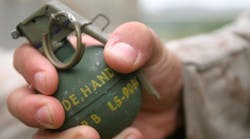Grenade testing machine. That phrase might have been printed on a box that Wile E. Coyote purchased from Acme Corp. for one of his hapless attempts to capture the Road Runner in their old cartoon series. However, in real life, grenades do need testing — not to see if they'll explode, but to ensure that the mechanism that triggers the explosion will work.
Custom machine fabricator Kaier Engineering, Lawrence, Pa., builds a machine that does just that for the U.S. Army. The machine performs three independent tests for functionality on the firing pin, safety clip, and safety ring. Specifically, it measures the force it takes to remove the pin and ring, as well as to detonate the primer. It also verifies that the detonation time is within specification.
The company recently upgraded an older design to improve safety, increase flexibility, and add more functions for statistical process control (SPC). Because all movements are between two discrete positions, pneumatics was still the lowest-cost actuation option and its use kept the redesign simple while making the new machine easy to build. An Allen-Bradley PLC controls the new machine. To keep costs down, Kaier only used direct wiring. The PLC provides feedback to the system with load cells to confirm the magnitude of the test forces.
In operation, the operator loads the machine at one of three different stations. After the guard doors close, he or she presses a button to initiate the test. Pneumatic cylinders pull the firing pin, opens a trap door, push off the clip, move tooling into place, release the pin, and hold and reload the firing pin. The machine automatically logs test results into the SPC.
Kaier designers selected Parker Hannifin's Isys line of plug-in solenoid micropneumatic valves for the testing machine. These valves meet the ISO 15407 dimensional and electrical standard. and also satisfy its quality and interchangeability criteria. Kaier engineers liked the fact that different size Isys valves mounted on the same manifold, without requiring transition plates. Several electrical connection options also contributed to flexibility. Sandwich flow controls and regulators simplified planning and mounting the pneumatic components.
Isys valves are available from Parker Hannifin's Pneumatic Div., Richland, Mich. For more information, call 269/629-5000 or click here to visit the website.
Click here to view a video detailing Parker's Isys micropneumatic valves.


